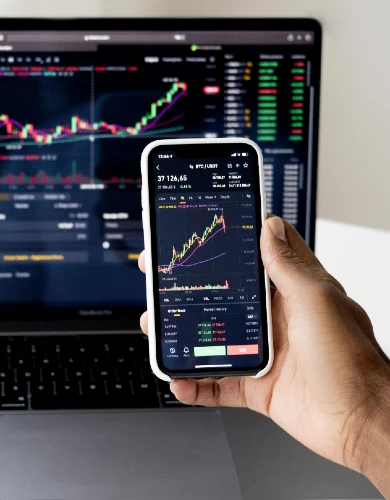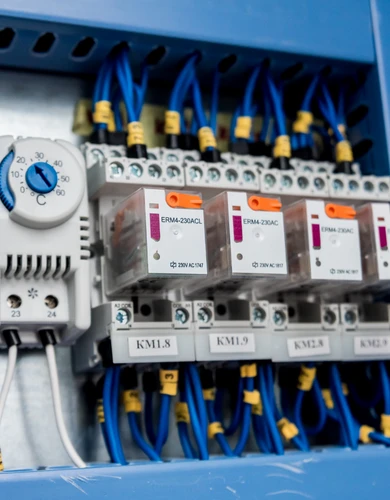The cost of commercial solar panel installations
Investing in commercial solar panels provides free, renewable electricity for decades, with minimal ongoing costs.
However, solar panels are a significant investment, and government support available in 2025 is limited. This article comprehensively explains the costs associated with a commercial solar system.
Here’s what we cover:
- Commercial solar panel cost factors
- Average costs for commercial solar panels
- Commercial solar panel installation costs
- Commercial solar battery cost
- Ongoing commercial solar panel costs
- Financing options for commercial solar panels
💡We have a separate guide explaining VAT on commercial solar installation costs.
Commercial solar panel cost factors
Before diving into the details of different types of solar costs, here are the most important factors determining the overall cost of a commercial solar system.
The scale of a commercial solar panel system
Larger commercial solar systems come with a higher upfront cost, as they require more panels and additional hardware for installation.
However, there are significant economies of scale with commercial solar panels. The larger the system, the lower the initial cost per kWh of output.
Costs such as labour, engineering, and inverter equipment do not increase proportionally with the number of panels, reducing the per-panel upfront cost.
Choice of solar panels
Commercial solar panels come in two main material types, at a standard size of 1 x 2 metres.
Higher-efficiency monocrystalline panels generate more power but cost approximately 20% more than polycrystalline panels.
For more details, refer to our guide on types of commercial solar panels.
Bespoke panels, such as those designed for solar carports, are more expensive than standard commercial solar panels.
Panel configuration
If no structural reinforcement is required, panels mounted on an existing flat roof offer the most cost-effective configuration for commercial solar panels.
In contrast, ground-mounted solar systems are typically more expensive, requiring initial land preparation and concrete foundations to support the racking systems.
Battery storage
A solar battery is an optional component of a commercial solar system that enables the storage of unused solar energy.
This is particularly useful for optimising solar energy consumption and avoiding peak prices on a multi-rate business energy tariff.
Purchasing a solar battery represents a significant additional upfront cost. See more below on the cost of a commercial solar battery.
Average costs for commercial solar panels
The table below shows the average upfront cost of equipment and installation for commercial solar panel systems across various sizes.
| Peak output | Number of panels | Average installation costs | Expected generation per year |
|---|---|---|---|
| 10 kW | 20 | £13,000 - £15,000 | 7,000 - 9,000 kWh |
| 20 kW | 40 | £16,000 - £30,000 | 14,000 - 18,000 kWh |
| 50 kW | 100 | £33,000 - £60,000 | 35,000 - 45,000 kWh |
| 100 kW | 200 | £60,000 - £120,000 | 70,000 - 90,000 kWh |
The costs above assume standard 1×2 metre monocrystalline solar panels mounted on a single flat roof, excluding solar batteries.
The final cost of a commercial solar system in the UK depends on several specific factors, which we’ll explain below.
Commercial solar panel installation costs
In this section, we’ll explain and estimate the various costs involved in installing a commercial solar panel system.
The figures below cover both ground-mounted and roof-mounted solar panels, as well as the most commonly used types of solar panels.
Solar equipment costs
The table below provides indicative costs for all hardware components in a commercial solar panel system.
| Component | Specification | Price | Explanation |
|---|---|---|---|
| Solar Panels (Monocrystalline) | 0.4 - 0.6 kW | £100 - £300 per panel | High-efficiency, long lifespan panel |
| Solar Panels (Polycrystalline) | 0.4 - 0.6 kW | £80 - £250 per panel | Lower-efficiency alternative |
| String Inverter | 5 - 250 kW | £5,000 - £50,000 | Supports between 10 and 500 panels |
| Hybrid Inverter (Required for Solar Batteries) | 5 - 200 kW | £7,000 - £50,000 | Supports between 10 and 400 panels |
| Central Inverter | 250 - 5,000 kW | £40,000 - £500,000+ | Supports between 500 and 10,000 panels |
| Mounting & Racking System (Rooftop) | Flat rooftop-mounted | £2,000 - £20,000 | Uses existing foundations |
| Mounting & Racking System (Ground-Mounted) | Ground-mounted | £5,000 - £50,000 | Requires ground anchor installation |
| Wiring & Electrical Components | — | £1,000 - £10,000 | Cost depends on overall system size |
Source: Data collected from wholesale trade prices in February 2025.
In the cost analysis above, we’ve excluded solar batteries, as they are not required in all commercial solar setups. See below for the cost of commercial solar batteries.
Installation and labour costs
Installation and labour costs are a significant part of the overall cost of commercial solar panel installation and can be comparable to the total cost of hardware.
The main activities involved in installing the hardware include:
- Initial site assessment and design – Engineering analysis, load assessments, and feasibility studies.
- Site preparation – Roof reinforcement where necessary or preparation of concrete foundations for ground-mounted solar.
- Installation – Labour and electrical work to install panels and wire up the inverter and other electrical components.
- Final inspection and commissioning – System testing, certification, and commissioning for operation.
The most significant factor influencing installation costs is the level of reinforcement or preparatory work required to support the solar panels.
We recommend arranging a site inspection with a commercial solar provider to obtain a bespoke installation quote for this element.
Commercial solar battery cost
Commercial solar batteries are an optional solar system component and require a significant additional upfront investment.
Large businesses typically use modular, rack-mounted lithium-ion batteries, which can be scaled to meet their specific energy storage requirements.
Our experts have collected wholesale prices for individual battery racks:
| Solar battery | Capacity | Price | Type |
|---|---|---|---|
| Tesla Powerwall | 13 kWh | £7,995 | Popular in domestic settings |
| Fogstar Energy | 30 kWh | £5,999 | Rack-mounted battery |
| Sunsynk HV12-SET-01 | 61 kWh | £15,000 | Rack-mounted battery |
Source: Data collected from wholesale trade prices in February 2025.
Ongoing commercial solar panel costs
Most of the cost of a commercial solar panel system is incurred during installation. However, there are some important ongoing costs to consider when conducting a return on investment analysis.
Below, we summarise the key ongoing cost elements.
Maintenance costs
Commercial solar panels require minimal maintenance, but installers typically recommend the following:
- Panel cleaning – 1-2 times per year
- Inverter inspection & servicing – Every 2-5 years
- Electrical system checks – Annually
Most commercial solar panel installers offer a maintenance contract that covers these routine activities, as well as the costs of emergency repairs.
We recommend budgeting between 2% and 3% of installation costs for annual maintenance fees.
Monitoring and control system costs
Solar monitoring and control systems for commercial solar panels provide real-time measurement of power generation and control over how electricity is used.
There are two main cost components for monitoring and control systems:
- Monitoring Software – Includes the user interface, reporting, analytics, and cloud storage. Typically charged as a monthly subscription fee.
- Monitoring Hardware – Used in more advanced Energy Management Systems, requiring an upfront investment for in-building sensors.
Find out more in our guide to business energy monitoring software.
Solar equipment replacement costs
Modern monocrystalline solar panels have a lifespan exceeding 40 years, but certain components of a commercial solar system require more frequent replacement:
- Inverter replacement – Typically required every 10-15 years.
- Battery replacement – Lithium-ion batteries also have an expected lifespan of 10-15 years.
Grid connection costs
If your business intends to use the Smart Export Guarantee to export excess power back to the grid, maintaining a business electricity connection will be necessary.
To stay connected to the local grid, businesses must pay a business electricity standing charge and meter operator costs.
The cost of a grid connection depends on the maximum import capacity of the connection.
Insurance costs
Most businesses choose to insure their commercial solar panels against risks such as fire, theft, and weather damage.
The additional cost of insuring commercial solar panels depends on your commercial property insurance provider’s policy.
Are there any financial incentives for commercial solar panels?
Unfortunately, no UK-wide grants are currently available for businesses investing in commercial solar panels.
However, the government and Ofgem provide three key forms of support for commercial solar investment:
- Smart Export Guarantee – The best business energy suppliers offer to purchase any excess electricity from customers, creating an additional revenue stream for businesses with solar panels.
- Corporation Tax Deductions – The Annual Investment Allowance (AIA) and First Year Allowance (FYA) allow businesses to deduct commercial solar installation costs from their taxable profit.
- Local Finance Support – Some local councils in the UK offer financial assistance and support for green business energy investments, such as solar panels. Use the gov.uk business finance support search to check for available schemes.
Financing options for commercial solar panels
Purchasing and installing commercial solar panels is a significant investment. However, UK businesses can finance the installation in three ways to avoid the upfront cost and instead make monthly payments over the long term.
In this section, we summarise the three main financing options:
Asset finance
Banks in the UK offer specific asset finance solutions that can be used to purchase business equipment, including commercial solar panels.
Asset finance for commercial solar is typically structured as a hire-purchase arrangement, where a business makes monthly payments to the bank over an agreed period.
Ownership of the solar panels is transferred to the business only after the final payment has been made.
Commercial solar leasing
Commercial solar installation firms often offer solar leasing.
In a solar leasing arrangement, a business makes monthly payments to the provider over a period of 15 to 25 years to cover the cost of the commercial solar installation.
On-Site Corporate Power Purchase Agreement (CPPA)
Under an On-Site CPPA, a third-party developer installs, owns, and maintains the solar panels on or near your commercial property.
A Power Purchase Agreement commits your business to purchase the electricity generated for a period of 5 to 20 years at an agreed business electricity price per kWh.
Find out more in our guide to purchasing energy with a corporate PPA.

